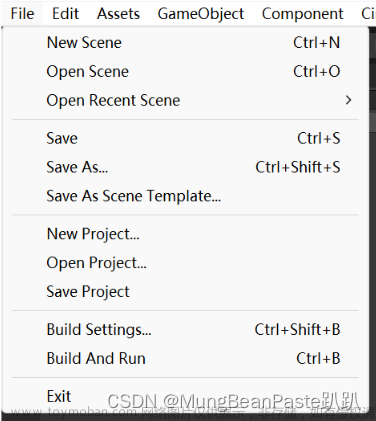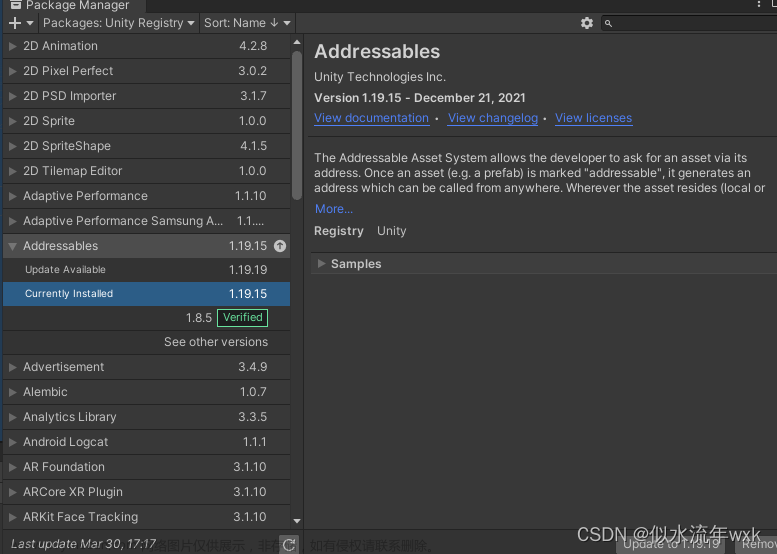前言
一、Unity官方给的动态资源加载方式
二、Unity中调用windows资源管理器
三、从资源管理器获得文件地址后复制到Unity指定文件夹
附上全部代码(不完善,仅框架)
前言
Unity官方给的动态资源加载方式就不赘述了。大体分为3种:(1) Resources.Load (2)AssetBundle(3) WWW加载 。 其中前两种大多用在本地资源加载,第三种用在web端从服务器加载。前两种都只能从特定的文件夹下面加载资源,也就是Asset下面特定名字的几个文件夹。
项目需求:打开win资源浏览器,从任意目录打开一个任意格式3D模型,加载进Unity主界面上。
一、Unity官方给的动态资源加载方式
给几个关键的链接和教程(讲的都很详细),以及官方文档(完全没懂在讲啥),有需要的自取
Unity日常 - 资源加载与文件路径_51CTO博客_unity动态加载资源的方式
Unity AssetBundle 打包 四种加载方式 服务器加载_荷兰猪小灰灰的博客-CSDN博客
AssetBundle 工作流程 - Unity 手册
二、Unity中调用windows资源管理器
关键教程链接:
Unity对于window下的资源管理器的基本操作_unity 打开windows资源管理器_以梦为马,不负韶华的博客-CSDN博客
但是这个教程中的文件格式过滤器有问题,会导致在文件打开窗口右下角的“类型选择”下拉表出现乱码以及过滤不正确等问题,具体格式应该如下:
_ofn.filter = "模型文件(*.obj)\0*.obj;"
+ "\0模型文件(*.stl)\0*.stl;"
+ "\0所有支持文件(*.obj *.stl)\0*.obj;*.stl\0";
说一下格式规则:
1、 \0*.obj 中间不能有间隔。
2、说明文字 “模型文件(*.obj)” 和给系统看的 “ *.obj”一定要用 “\0” 隔开。
3、不同的类型之间用“;” 隔开。
三、从资源管理器获得文件地址后复制到Unity指定文件夹

这里建立了一个缓存文件夹“ModelsBuffer”具体代码如下:
// 如果读取成功,转成OBJ先放入缓存文件夹:Resources/ModelsBuffer;
bool judge_FileBuffer = false;
if (LocalDialog.GetOpenFileName(_ofn)){
String path_Buffer = Application.dataPath + "/Resources/ModelsBuffer/";
bool judge_Path = false;
if (!Directory.Exists(path_Buffer)){
Directory.CreateDirectory(path_Buffer);
judge_Path = true;
}
else {
judge_Path = true;
}
if (_ofn.fileFull.Length != 0 && judge_Path) {
String dir_FilenameFull = path_Buffer + _ofn.fileTitle;
System.IO.File.Copy(_ofn.fileFull, dir_FilenameFull, true);
AssetDatabase.Refresh();
judge_FileBuffer = true;
}
else{
Debug.Log("文件路径为空或存在不支持的语言符号种类");
}
}
切记Copy完文件一定要做一次AssetDatabase.Refresh(),刷新Unity的资产包,这样Unity才能在Resources/ModelsBuffer文件夹下正确获取文件。文章来源:https://www.toymoban.com/news/detail-762047.html
然后再从缓存下加载,具体代码如下:文章来源地址https://www.toymoban.com/news/detail-762047.html
// 从缓存文件夹下加载模型;
if (judge_FileBuffer){
String _tempFN = _ofn.fileTitle.Substring(0, _ofn.fileTitle.Length - 4);
var _obj = Resources.Load<GameObject>("ModelsBuffer/" + _tempFN);
if (_obj){
var _objInstant = Instantiate(_obj);
_objInstant.transform.localScale = Vector3.one * 30;
_objInstant.transform.localPosition = new Vector3(10f, -11.7f, 174.7f);
}
}附上全部代码(不完善,仅框架)
using UnityEditor;
using UnityEngine;
using UnityEngine.UI;
using System;
using System.IO;
using System.Collections;
using System.Runtime.InteropServices;
using FileIO;
// ------------------------------------------------ 主程序运行类 ------------------------------------------------ //
public class LoadFiles_win10 : MonoBehaviour
{
// ------------------------------------------------ 打开模型;
// 3.单击后打开文件浏览器:
public void Click_OpenFileDialog()
{
//Debug.Log("getIn Click_OpenFileDialog");
FileNameStruct _ofn = new FileNameStruct();
_ofn.structSize = Marshal.SizeOf(_ofn);
_ofn.filter = "模型文件(*.obj)\0*.obj;"
+ "\0模型文件(*.stl)\0*.stl;"
+ "\0所有支持文件(*.obj *.stl)\0*.obj;*.stl\0";
_ofn.fileFull = new string(new char[256]);
_ofn.maxFile = _ofn.fileFull.Length;
_ofn.fileTitle = new string(new char[64]);
_ofn.maxFileTitle = _ofn.fileTitle.Length;
_ofn.initialDir = Application.streamingAssetsPath.Replace('/', '\\');//默认路径
_ofn.title = "载入模型文件";
_ofn.flags = 0x00080000 | 0x00001000 | 0x00000800 | 0x00000008;
// 如果读取成功,转成OBJ先放入缓存文件夹:Resources/ModelsBuffer;
bool judge_FileBuffer = false;
if (LocalDialog.GetOpenFileName(_ofn)){
String path_Buffer = Application.dataPath + "/Resources/ModelsBuffer/";
bool judge_Path = false;
if (!Directory.Exists(path_Buffer)){
Directory.CreateDirectory(path_Buffer);
judge_Path = true;
}
else {
judge_Path = true;
}
if (_ofn.fileFull.Length != 0 && judge_Path) {
String dir_FilenameFull = path_Buffer + _ofn.fileTitle;
System.IO.File.Copy(_ofn.fileFull, dir_FilenameFull, true);
AssetDatabase.Refresh();
judge_FileBuffer = true;
}
else{
Debug.Log("文件路径为空或存在不支持的语言符号种类");
}
}
// 从缓存文件夹下加载模型;
if (judge_FileBuffer){
String _tempFN = _ofn.fileTitle.Substring(0, _ofn.fileTitle.Length - 4);
var _obj = Resources.Load<GameObject>("ModelsBuffer/" + _tempFN);
if (_obj){
var _objInstant = Instantiate(_obj);
_objInstant.transform.localScale = Vector3.one * 30;
_objInstant.transform.localPosition = new Vector3(10f, -11.7f, 174.7f);
}
}
// 模型文件读取后转入数据库;
if (judge_FileBuffer) {
bool judge_Read = false;
FileIO_OBJ _io = new FileIO_OBJ();
judge_Read = _io.read_OBJ(_ofn.fileFull);
}
}
// ------------------------------------------------ 保存模型;
public void Click_SaveFileDialog()
{
Debug.Log("getIn Click_SaveFileDialog");
FileNameStruct _sfn = new FileNameStruct();
if (LocalDialog.GetSaveFileName(_sfn))
{
}
}
}
// ------------------------------------------- win10 文件浏览器调用类 ------------------------------------------- //
[StructLayout(LayoutKind.Sequential, CharSet = CharSet.Auto)]
//1.OpenFileName数据接收类:
public class FileNameStruct
{
public int structSize = 0;
public IntPtr dlgOwner = IntPtr.Zero;
public IntPtr instance = IntPtr.Zero;
public String filter = null;
public String customFilter = null;
public int maxCustFilter = 0;
public int filterIndex = 0;
public String fileFull = null;
public int maxFile = 0;
public String fileTitle = null;
public int maxFileTitle = 0;
public String initialDir = null;
public String title = null;
public int flags = 0;
public short fileOffset = 0;
public short fileExtension = 0;
public String defExt = null;
public IntPtr custData = IntPtr.Zero;
public IntPtr hook = IntPtr.Zero;
public String templateName = null;
public IntPtr reservedPtr = IntPtr.Zero;
public int reservedInt = 0;
public int flagsEx = 0;
}
//2.系统函数调用类:
public class LocalDialog
{
//链接指定系统函数 打开文件对话框
[DllImport("Comdlg32.dll", SetLastError = true, ThrowOnUnmappableChar = true, CharSet = CharSet.Auto)]
public static extern bool GetOpenFileName([In, Out] FileNameStruct ofn);
public static bool GetOFN([In, Out] FileNameStruct ofn) { return GetOpenFileName(ofn); }
//链接指定系统函数 另存为对话框
[DllImport("Comdlg32.dll", SetLastError = true, ThrowOnUnmappableChar = true, CharSet = CharSet.Auto)]
public static extern bool GetSaveFileName([In, Out] FileNameStruct ofn);
public static bool GetSFN([In, Out] FileNameStruct ofn) { return GetSaveFileName(ofn); }
}
到了这里,关于Unity动态加载资源 - 从硬盘任意地址加载任意格式3D模型的文章就介绍完了。如果您还想了解更多内容,请在右上角搜索TOY模板网以前的文章或继续浏览下面的相关文章,希望大家以后多多支持TOY模板网!











